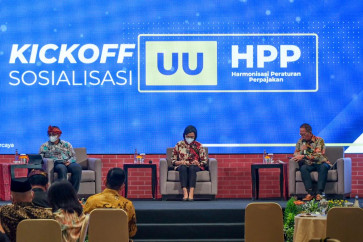Popular Reads
Top Results
Can't find what you're looking for?
View all search resultsPopular Reads
Top Results
Can't find what you're looking for?
View all search resultsThe new landscape of value-added tax on collateral
The policy has provided a level playing field between those who buy property through developers and those who do so through auctions or outside auctions.
Change text size
Gift Premium Articles
to Anyone
T
here is a new landscape of value-added tax (VAT) on collateral in the form movable or immovable collateral in the form property after the issuance of Government Regulation No. 44/2022, an implementing regulation on the Tax Standardization Law (HPP), at the end of 2022. Then, what is the concept for taxation and the imposition of VAT on collateral?
Article 10 of the regulation emphasizes that the transfer of rights to taxable goods can also occur because of an agreement. In this context, the definition of transfer of rights over taxable goods due to an agreement is the delivery of collateral by the creditor to the buyer. Still the same article stipulates that collateral is a category of taxable goods that are taken over by creditors based on mortgage rights over land and objects related to land, fiduciary guarantees, mortgages, pledges or other similar charges.
So if the elements in the article are withdrawn, first, there is the delivery of collateral belonging to the borrower to the creditor. Second, the collateral is bound based on agreements including mortgages, fiduciary guarantees, mortgages, pledges and the like. Third, there is a default from the borrower so that the creditor takes over the collateral, commonly known as AYDA, or foreclosed collateral. Fourth, the foreclosed collateral is purchased by a third party or purchased by a creditor, either at auction or privately.
When viewed from these four elements, the legal event for which VAT is payable is the fourth event, namely the delivery of collateral to a third party or by a creditor to be owned. Whereas in the first element, there is no VAT payable yet, because in accordance with Article 1A of the VAT law, the delivery of taxable goods from the owner as collateral for debt, is excluded as a delivery of VAT payable.
Then, the question is whether the government's imposition of VAT on foreclosed assets, or commonly known as AYDA, is on target. Bearing in mind that before the regulation, which was a derivative of the HPP Law, was issued, the government and the legislature through the law had changed the substance of the imposition of VAT on financial services, which was originally not a VAT object, to become a VAT object that obtained exemptions.
First, considering the substance that the nature of VAT is a consumption tax on goods and services, the burden of imposing VAT ultimately lies with and is borne by consumers. So in simple terms, we can ensure that the collection of VAT on the transfer of collateral will be a burden on the buyer who has been executed by the bank. The buyer can be a third party or the bank itself when purchasing the collateral.
The policy regarding the imposition of VAT on the transfer of rights to collateral to buyers or third parties is appropriate, on the grounds that this policy has provided an equal level playing field between property buyers through developers and property buyers either through auctions or outside auctions.



















